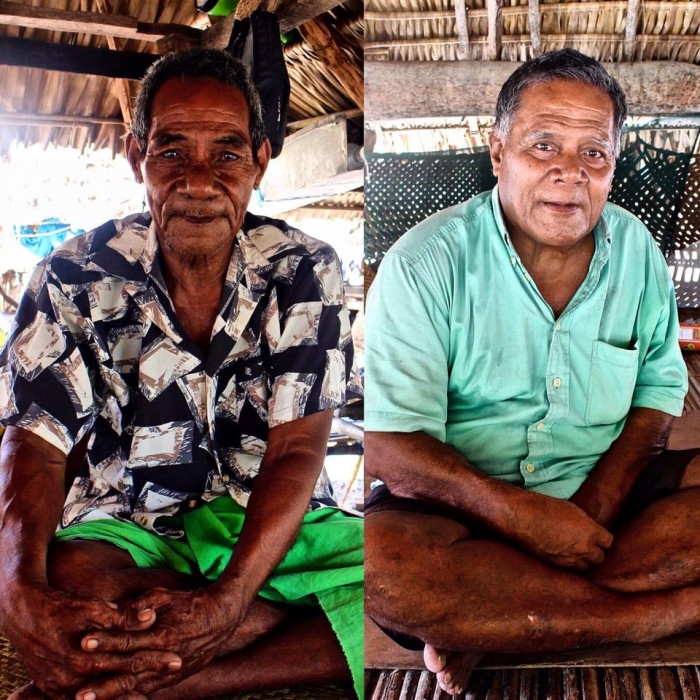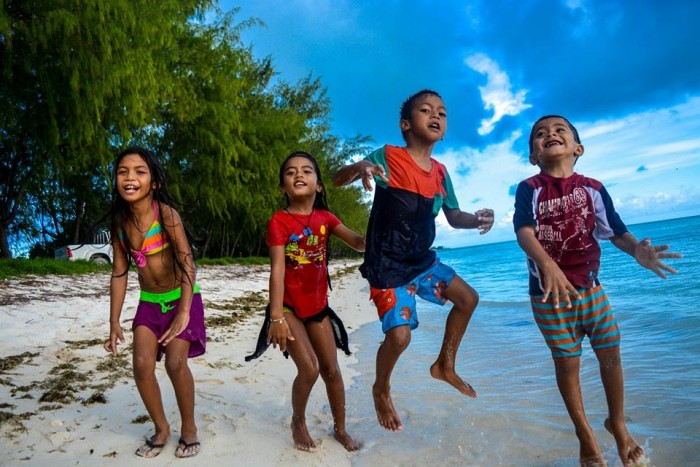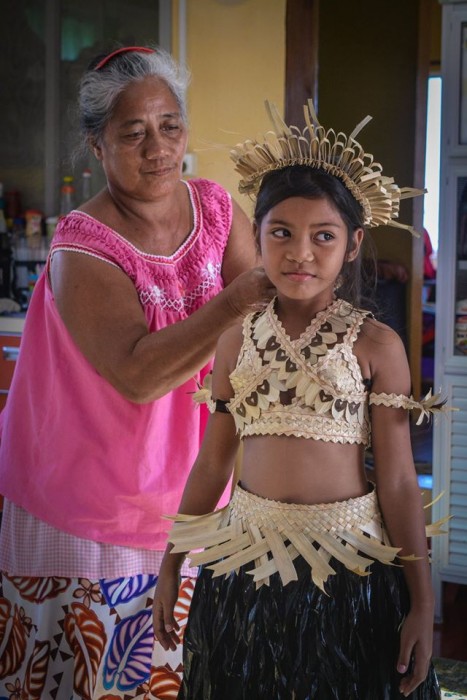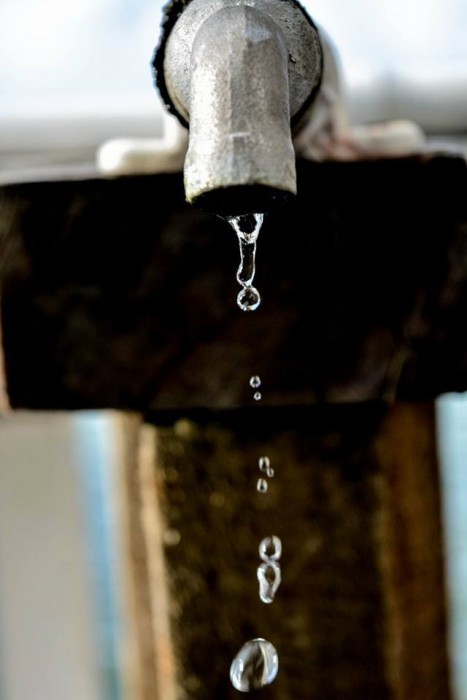This post is presented in this week’s series recognizing Earth Day, Friday, April 22.
On 16 November 1989, Kiribati Minister of Home Affairs and Decentralization Babera Kirata addressed the general forum at the Small Island States Conference on Sea Level Rise in Malé Island. Highlighting his nation’s concern over the emerging greenhouse effect theory, he stated:
Over the centuries the question of rising in sea level was never heard of. Our ancestors had lived happily for centuries on our islands, without fear that one day, our beautiful homes may be lost as a result of the deterioration in the environment. We in this present generation have inherited those small islands and we are very proud to be owners of the beautiful homes, which our ancestors had secured for us … The ground water would easily become saline, making it impossible to obtain potable water, and agriculture would be destroyed. The plankton upon which fish live on will disappear, and the livelihood of Kiribati people, who depend on fish, would be seriously affected. The effect of rising in sea level, accompanied by strong winds and high waves would be disastrous for Kiribati. (Kirata 1989: 2–3)
His remarks highlighted the intimate connection I-Kiribati (people from Kiribati) have with their land. Land in Kiribati defines one’s sense of personhood; it is as much a part of them as they are of it. When I-Kiribati are born, they are traditionally born on their land. They grow up and have families of their own on that land. When their time comes, their bodies return to the land. Their spirits join the ancestors who have gone before, and together they watch over future generations of the land. Land, in Kiribati, cosmologically ties one’s past, present, and future together. If sea levels were to rise as predicted, the physical challenges for survival would be daunting. The challenges associated with Kiribati identity and personhood could very well be insurmountable.
Experts say that the tiny Pacific Island nations, which collectively account for a mere 0.0012 percent of global greenhouse gas emissions, are the most vulnerable and would be the first to feel the full brunt of global warming (Singh 2007: 1). To date, Kiribati has experienced devastating king tides, prolonged droughts, extended periods of rain, and, more recently, unprecedented cyclonic activity in the doldrums of the Pacific. Iorita Toromon describes the night that Cyclone Pam arrived in Tarawa:
Yesterday and last night March 9, 2015, south Tarawa experienced strong winds with rough seas and high tides causing further destruction. Most of the seawalls, which were recently constructed, are now destroyed. Roads are covered with sand, gravel, and big stones from the ocean again. Residential houses along the coastal area are greatly affected by the strong waves too. Our lives are very threatened by sea level rise and we are worried about our future. Our wells, which are our only source of fresh water, have become salinized and are rendered unsuitable for drinking now. Our main food plants such as breadfruit and pawpaw are dying because of the ocean. Many workers do not want to go to work, as they stay home to rebuild seawalls from the rubble before the next high tide in a few days’ time. (Toroman 2015)
She ends in fearful anticipation of the approaching king tide, an abnormally high tide that has become more powerful and brought greater devastation to all islands in Kiribati over recent years. She has great reason to worry, as her house was located on land that rose just a couple inches above the ocean during high tide. Most islands in Kiribati are thin strips of coral that rise, at most, just several feet above sea level. The lands I-Kiribati live on today are ancient barrier reefs that once surrounded high volcanic islands. Over tens of billions of years, these towering volcanic islands subsided below the ocean, leaving a thin barrier reef behind. Early settlers of these islands, some four or five thousand years ago, lived in a delicate balance between man and nature. They exploited their environment in its totality, and their cultures evolved in harmony with it (Macdonald 2001: 4–5). Very little has changed since then.
I first went to Kiribati as a Peace Corps volunteer in 2000. I left home knowing very little about global warming, and when I arrived in Kiribati, I felt like I should have looked more into the subject. In my first letter home, I wrote this passage:
It’s so pretty here, but scary too. I heard about global warming and I just wonder if it is true. Being here sure makes it seem real. But, I guess I trust the US government. They wouldn’t send us here if they thought it was a problem. I asked one of my Kiribati teachers about global warming and he assured me that it was nothing serious. He said, people have been saying that Kiribati would go under the ocean ever since the 1980s, and look, we are still here. So, Mike, don’t worry.
Over the past sixteen years, however, the growing devastation from the impacts of climate change has worried many in Kiribati. As a Peace Corps volunteer, I rarely heard any discussion about global warming in the village. Whenever I brought up the subject, close friends and family would laugh at the idea. Friends and adopted family members would reassure me that Kiribati was safe from drowning by pointing to rainbows (an almost daily occurrence on the equator), and saying things like, “See! There is his promise in the sky, we are safe!”
I returned in May 2004 for work on my first master’s degree in on the growing HIV/AIDS prevalence rates and social stigma. Then, Tarawa was experiencing an unusually prolonged drought, and months before an unusually high king tide had washed over the land. The impacts of a rapidly changing environment were now being felt. However, most people I talked with in this largely Christian nation held onto the biblical teachings of faith and obedience. It wouldn’t be much longer before the evidence changed people’s minds about climate change. A ten-year time lapse of a village adjacent to my host family’s village, Abarao Village, is provided to exemplify the damages experienced in Kiribati.

Host family elders laughed at me when I asked them about moving away from Kiribati if the situation were to become worse. In response, I would hear a chorus of, “I am from Kiribati, my land is here, and I will not leave.” The connection they have to their land is so strong that even the encroaching tide may prove too weak to break this bond.
On the other hand, Kiribati senior secondary schools graduate thousands of students each year. Of these, a handful will earn scholarships and continue their studies overseas. Some will continue schooling at local training institutions, and a few will find employment in Kiribati. The majority of graduates will return home. For this population, the opportunity to work overseas is an opportunity of a lifetime.
In 2001, New Zealand began accepting up to seventy-five Kiribati citizens each year through its Pacific Access Category (PAC) migration scheme. To qualify for the lottery, citizens must meet certain age, health, and character requirements. If picked, lottery winners must then obtain a job offer from a New Zealand–based employer. When employment is secured, the individual and immediate family can migrate to New Zealand as permanent residents. In 2007, New Zealand implemented a new work-based migration scheme. The aim of the Regional Seasonal Employer (RSE) scheme was to fill labor shortages in the New Zealand agricultural industry.
That same year, Ioane Teitiota, an RSE migrant worker, traveled to New Zealand with his wife. He worked in the agriculture industry while his wife worked in a rest home. During a 2011 routine traffic stop, Ioane was arrested when New Zealand authorities discovered that he had overstayed his work visa. Wanting only to extend his visa, he reached out to Michael Kidd, an Auckland-based attorney. His case took a monumental turn when his extension was denied, and Kidd argued for his stay based on humanitarian criteria. Ioane’s case unexpectedly became a seminal case in the fight for climate refugee status (Weiss 2015). Ultimately, after a four-year battle, Ioane lost and was forced to return to Kiribati with his wife and three New Zealand–born children. In its final ruling, the court stated that “a ‘sociological’ refugee or person seeking to better his or her life by escaping the perceived results of climate change is not a person to whom Article 1A(2) of the Refugee Convention applies” (Buchanan 2015).
While the world continues to argue over the legal definition of climatically induced migrants, former president of Kiribati, Anote Tong, continues to work tirelessly to tell the world about his country and to create plans for an eventual relocation. In 2014, he purchased a 20-square-kilometer plot of land on Fiji’s Vanua Levu island for $8.77 million. The original purpose of the land acquisition was for agricultural purposes, but during a recent climate change conference in New Zealand, Tong stated that the land’s main value was for international publicity and to give his people a sense of security: “People are getting quite scared now and we need immediate solutions. This is why I want to rush the solution, so there will be a sense of comfort for our people” (Radio New Zealand 2016).
Kiribati is just one of many nations on the frontlines of climate change. My friends and adopted family members in Kiribati have silently suffered great losses in crops and houses, and they have even buried their own children because of the impact climate change is already having on the country. What happens in Kiribati and other frontline nations should be a wakeup call for the entire world, but unfortunately, few people know Kiribati exists. To help spread the news from Kiribati, a small group of Kiribati youth and concerned individuals from around the world have created Humans of Kiribati, an online showcase of stories from the frontline. Over this past year, thousands of followers have contributed toward the success of the project. International media, movie producers, foreign governments, and everyday citizens like, share, and follow on Facebook and Instagram. We invite you to help us by sharing our pictures and stories. Our goal is to teach others about Kiribati culture, language, and lifestyle. We want to build a human connection to others and have the world know about Kiribati before it is gone. Through collective global inactions, Kiribati’s time is limited. I remain hopeful that my generation will find ways to move beyond our ways of today—not necessarily because we want to but because we have to.
Sample Posts from Humans of Kiribati

On top of recently losing their wives, both of these unimane (elders) from Marakei Island just lost their land to the most recent king tide. Itiaake Teuria, 70, on the left, had to move inland with his relatives, but when he passes the place where his old home used to be, it reminds him of the life he built with his wife and the forty-plus years of marriage they spent on that land. Maneteata Ruotaake, 69, on the right, lost his house, his kitchen, and all of his trees, but he refuses to leave his land because his wife is buried here. He wants to be buried with her, even if the waves take away the land before that time comes.

Children in Kiribati are blessings to families. Adoption in Kiribati is a custom, which serves to bring people closer together through the exchange of children. The practice often serves to unite rather than separate families from one another. However, for children adopted outside of Kiribati, the dichotomy of life can be very challenging.
For me, I would say my heart is here … with me in Australia, but my soul is in Kiribati. I have always known since I was little that I was adopted. Aside from my darker skin, I never saw myself as being different growing up. I don’t think my friends saw me as different. As I grew older, people would come up to me and ask me where I was from. They tried to guess but they never got it right—no one knew about Kiribati.
When I told them a small country in the Pacific Ocean, I’d get, “Why are you here?” or, ”Shouldn’t you be in warmer weather?” I always just say, well I don’t know because I’ve grown up, here so I don’t know anything different. I look forward to the day I return, someday…

Learned from elders, Kiribati dance is an art, which reflects our strong communal ties. Groups of dancers focus on the movements of their bodies. Their hands, arms, and feet move to the rhythm and beat of the song while their heads and eyes tell the story. Behind the dancers, singers and musicians perform with all their might to make the dance exciting. The whole performance reflects the unity and support our society provides to one another. The art conveys the idea that “in life there is always a time for everything, place for everyone, and amidst difficulties, anxieties, and turmoil life will still go on.”

Looking toward the possibility of what our future brings and seeing this wrecked ship on shore give me butterflies. What will it be like when the next king tide hits our small island? How many houses will be destroyed when it hits? What else will wash ashore? Why do we in the Pacific have to suffer from this? Sometimes I ask myself, “What future lies ahead, and how much longer can our motherland battle climate change?”

When I returned from Peace Corps service, America was a different place. It was not home any longer—not like it was before I left. Friends and family were happy to see me, but I couldn’t relate to them like before. Striking up a conversation was difficult. They talked about movies, clothes, jobs, and money. Absentmindedly, I just stared in amazement at the amount of material things around me. Sleeping in a bed was difficult. I hadn’t slept on something soft for years, and I froze when temperatures dropped below 80 degrees. Water fountains. I. Loved. Water. Fountains. Like no one else! The water didn’t need to be boiled, filtered, and cooled overnight. You just pushed a button and drank!
Things I cherished in the village (talking, close human relationships, and a slower-paced life) did not seem to be valued in America. It was all about going—going to work, going to school, going to appointments. Going, and most of these goings seemed to somehow revolve around money. It was a far cry from the village, where living revolved around people. People, not money, were the focus of life. When I came back, reverse culture shock got the best of me most nights. I would often cry myself to sleep, just wishing to be back home in Kiribati. Like water, Kiribati gave me life. It taught me (an American) what is important and how to truly live with others!
Mike Roman received his PhD from the Department of Anthropology at the University of Pittsburgh in 2014 and is currently at the University of Cincinnati.
References
Buchanan, Kelly. 2015. “New Zealand: ‘Climate Change Refugee’ Case Overview.” Washington, DC: Law Library of Congress (accessed 16 April 2016).
Kirata, Babera. 1989. “Kiribati Country Statement.” Presented at the Small States Conference on Sea Level Rise, 14–18 November, Malé (accessed 15 April 2016).
Macdonald, Barrie. 2001. Cinderellas of the Empire. Suva, Fiji: University of the South Pacific.
Radio New Zealand. 2016. “Kiribati Climate-Induced Migration to Start in Five Years.” RNZ, 16 February (accessed 16 February 2016).
Singh, Shailendra. 2007. “Climate Change: South Pacific More Vulnerable Than Thought.” IPS, 22 February.
Toromon, Iorita. 2015. Personal communication, 19 March.
Cite as: Roman, Mike. “Kiribati and Climate Change in Kiribati.” EnviroSociety, 20 April. www.envirosociety.org/2016/04/kiribati-and-climate-change-the-untold-story.
